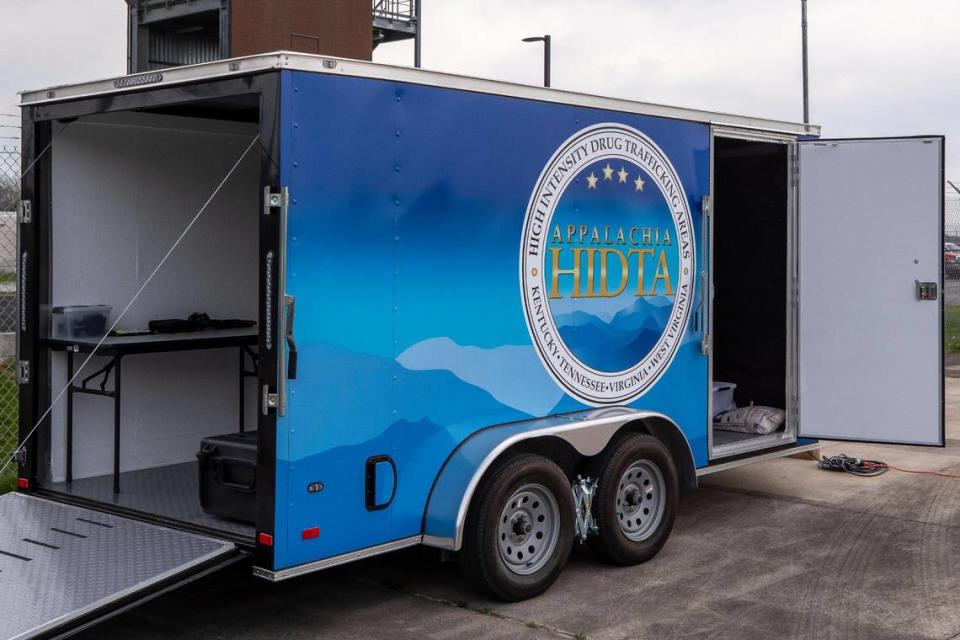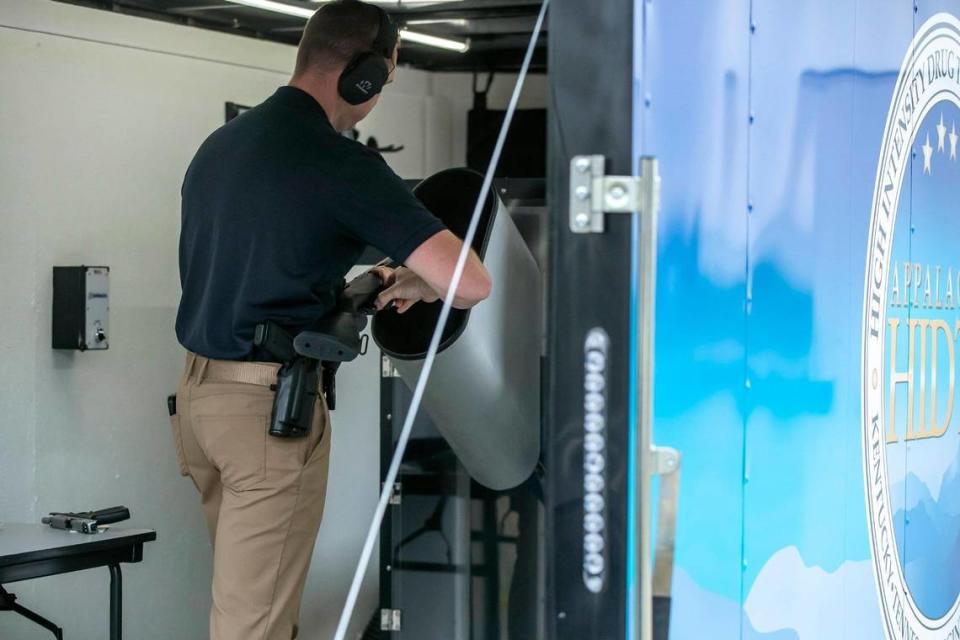ATF, law enforcement work with new technology to trace guns across Appalachia
With illegal drug operations plaguing the hills of Appalachia, 52 task forces have been formed across four states in efforts to dismantle as many criminal drug organizations as possible.
Based in London, the Appalachia High Intensity Drug Trafficking Area task force has an opportunity to expand its resources further with the help of the Bureau of Alcohol, Tobacco, Firearms and Explosives through a new mobile technology unit.
Vic Brown, the director who oversees all 52 groups within the task force, said the drug trade and violent crime involving firearms go hand-in-hand.
Brown said the group was “very lucky to have partnered with the ATF” for the mobile unit, which will use firearm ballistic imaging to connect guns to different crimes and give new leads where there may have not been any before.
“It’s a great opportunity to be able to solve a lot of crimes across the country whether they originate in this area or they are crimes brought into this area from other locations,” Brown said.

Shawn Morrow, special agent in charge with the ATF Louisville Division, says the agency’s main priority is disrupting violent crime involving firearms.
“First and foremost – I will say it over and over – we are a law enforcement agency that prioritizes violent crime,” Morrow said. “It is important for people to understand that ATF is absolutely focused on crime guns. We are absolutely focused on individuals who are using guns to hurt other people, to hurt our communities and that is where we focus our resources.”
One of those resources is strong partnerships, Morrow said.
Appalachian task forces band together with ATF’s help
The ATF has large involvement with other state and local agencies through partnerships to address violent crime. Specifically, the ATF works with the Appalachia task forces, who have a mission to enhance and coordinate drug enforcement efforts of local, state and federal law enforcement agencies.
The group’s focus is within areas designated as high drug trafficking areas. The Appalachian group serves four states – Kentucky, Virginia, West Virginia and Tennessee. Within those four states there are 52 task forces made up by the best investigators in their respective law enforcement agencies.
The majority of the task forces — 65% — are in Kentucky and West Virginia, which fall under the purview of the Louisville Division of the ATF, according to Morrow.
“(The Appalachian enforcement group’s) primary focus is dangerous drugs, and dangerous drug distribution,” Morrow said. “But drugs and firearms go hand-in-hand. We know that drug trafficking operations use guns to protect their turf, to expand their turf, to retaliate. (Dealers) do shootings, they do robberies, they do all kinds of violent crime to make sure their drug trafficking operation survives.”
The ATF also provides resources to communities that need help reducing violent crime. Morrow said it’s important those local agencies have the tools to investigate those crimes.
“So we don’t want to be solely focused on drugs, we want to be focused on armed drug trafficking organizations and on drug traffickers that are using guns to hurt other people in drug trafficking operations,” Morrow said. “That is where ATF comes in.”
Morrow said a lot of crime in media headlines can be centralized to urban areas with a high number of shootings. In his experience, Morrow said largely populated areas receive the most federal resources. But these violent crimes are not solely isolated in larger populations.
“Firearm-related crime and firearms-related offenses also occur in our rural areas,” he said. “It is important at ATF that we make those resources available to all police agencies. … I want to make sure that those communities have access to technology, to professional intelligence products, and to ATF special agents that can help with these really serious crimes.”
A ‘mobile unit’ provides investigative help to local cops
The Appalachian task force traces and investigates around 2,000 firearms annually, Morrow said. After seizing a gun, investigators work to determine where it came from, if it was purchased legally, if it was used in other crimes or if it was used in drug trafficking.
If these guns were used in crimes, the ATF relies on the National Integrated Ballistic Network to make connections. New, mobile technology is available to the ATF and its partners to help widen access to federal resources and provide education to local law enforcement agencies.
That national network “is designed to take firearms evidence from different scenes and analyze that and draw links together,” Morrow said.
“It could be compared to fingerprints for firearms,” Morrow said. “So each firearm when it is fired will discharge a shell casing and that shell casing will have a unique marking on it which is specific to that firearm. Like a fingerprint. So if a gun is used to commit a shooting, and different shootings, even if it crosses jurisdictions – city, state, or anywhere else in U.S. – we have the ability to match those crime scenes.”
According to the ATF’s website, 116,233 investigative leads were generated by 242 network machine locations in 2020.
Historically, police agencies have had access to four machines to access the ballistic network throughout the state to submit evidence for testing. A fifth machine is in the works. Now, the ATF and partners implemented a mobile ballistic network unit in February 2023 which moves among the 52 task forces the Appalachian task force group serves.
In Kentucky, there are two machines in Louisville, one in Lexington, and one with a state police agency.
Morrow said that when the mobile unit goes to a police department or task force, it’s available to all the local law enforcement agencies.
The mobile unit is a box truck that has space where criminal intelligence analyst Kevin “Chip” Chipley will operate the ballistics network machine. It’s also equipped with a “shoot trailer” where live rounds can be fired from each firearm. The mobile operation costs around $500,000, with nearly half of that going to the testing network alone, according to Brown.

ATF agents can take the “shoot trailer” to law enforcement officers, who can bring their evidence, fire the gun and produce a shell casing. The shell casing can be entered into the ballistic network system after being processed through the Brass Trax ballistics imaging software. Once images are produced, they are sent to the ATF’s National Correlation and Training Center in Huntsville, Alabama, for comparison.

Results can be produced anywhere between 24 and 48 hours. In emergency situations, the center can conduct an urgent review and provide results within hours.
“The more rounds that get put in the system, the better opportunity you will have for a better match,” Brown said. “So this system is relatively young so over the years as more and more get entered in there you have a better opportunity for case matching.”
‘Love having new tools to try and catch bad guys’
Captain Shawn Dobbs of the Somerset Police Department had his first experience with the shoot trailer and network analysis in early April. He brought four firearms to be tested, including a .308 long rifle, a .223 caliber firearm, a .40 caliber pistol and a 9 mm handgun.
His department has nearly 400 firearms in their evidence room which could be tested and connected. He hopes to have them all entered into the network ballistic systems.
“Just like fingerprints being entered into CODIS or AFIS, the more you get into the system, the more matches you are going to be able to make. It is imperative for these agencies to get all of these test fires put into the system,’ Dobbs said.
While the mobile unit and network are still new to local law enforcement, Dobbs is hopeful it will be a helpful tool to stop violent crime at any level.
“I love having new tools to try and catch bad guys,” Dobbs said. “That is the goal, we want to help people and save lives. If we can’t save lives, we can catch the person that took it. That is the main thing for us.”
Crime Gun Intelligence Centers
Using the mobile unit to analyze shell casings to different crime scenes allows investigators to draw similarities for location, suspects, associates and vehicles — also known as crime gun intelligence. These connections are made at the Louisville-based Crime Gun Intelligence Center.
The Crime Gun Intelligence Center leverages the 52 Appalachian-focused task forces to ensure they have federal resources and ATF information to identify crimes and successfully investigate them. These centers are “intelligence hubs” and coordination centers for state and local agencies to help solve major crimes involving firearms.
The Louisville-based Crime Gun Intelligence Center also assists law enforcement with other aspects of crime gun intelligence, including tracing the crime gun. Investigators use this data to uncover patterns of firearms trafficking and identifying illegal and “straw” firearms purchasers.
Hard to trace, until it’s too late: How KY guns end up in out-of-state crime scenes
“The information from those traces have helped strengthen federal cases and open new cases — just from those firearms. We know, in some communities, drug traffickers are driving violence — so, it makes sense that we come together with (the Appalachian task force group) and partner on this initiative,” said Special Agent Cassandra Mullins, an ATF spokesperson.
“The work our London ATF Office is doing, and the violence they are seeing, we want to make sure those resources are there for our rural communities.”
A culture of violence sees women become an ‘insurance policy’ for KY’s illegal drug trade

